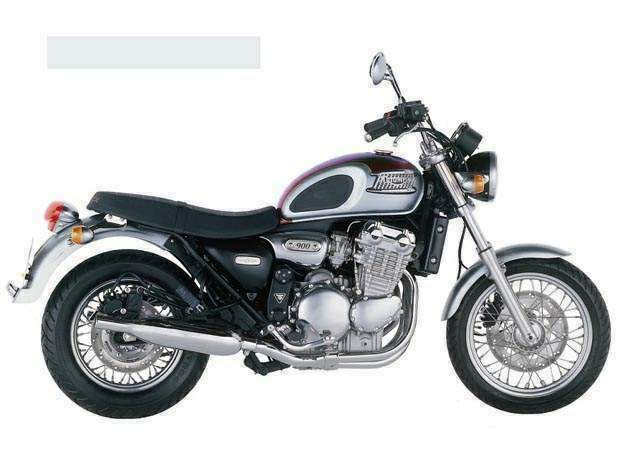All Hinckley Triumph engines produced from 1991 to 1995 had the same 76mm pistons and iron cylinder liners. The only difference was in the stroke (55mm or 65mm) or number of cylinders (three or four). This is the essence of the T3 engine series.
The advent of the T5 series, specifically the T595, changed this - 79mm pistons and nikasil coated alloy liners came along with a completely new engine design. Only it was completely completely new. The stroke was the same 65mm as the T3 900 and 1200 motors and gudgeon pin size is the same. I think the conrods are also the same. So Hinckley triples eventually all became 955 cc, courtesy of a 3mm wider bore (pie ar squared eitch times three = 955825.652). What if the fours had followed a similar progression? 39.5 x 39.5 x 64 x 3.1415927 x 4 = 1274434.202.
I had heard that it is possible to fit 955 liners and pistons to the T3 engines and, searching web forums, came across a few references to Jim's Thunderbird. The first Hinckley Thunderbirds were very similar to the other triples in the range - same pistons and liners as the Trident, Speed Triple etc. The cases are different though essentially in only cosmetic ways.
Unfortunately, the links to Jim's article were all broken. Then I remembered the WayBackMachine and was happy to see the article had been archived.
Jim Bush, a gentleman from Canada, managed to machine his 885cc Thunderbird engine cases so they would accept liners and pistons from a year 2000 Daytona 955i. In fact, he also found the cams were interchangeable on the triples.
The key part of the article is:
"In August this year (2003), I decided to take
the plunge and tear down the Tbird – I needed to do the starter sprag gear upgrade
anyway (a $2600 fix at a local shop). Once all the oil was cleared away, I was
able to determine that the cylinders of the 955 were on the same centres as the
885 which meant that the sleeves could essentially fit. The stroke was the same
on both engines, just an increase in bore. I found the cams were
interchangeable, but the gearbox was not – it was 32mm narrower, so I couldn’t
transplant the 6 speed trannie which I had been really counting on (bummer!).
Buy hey, I could now install the starter gears, machine the engine casing to
accept the 955 sleeves, use the 955 11:1 forged pistons and heavy duty Daytona rods, install the
Daytona cams and valve springs.

The
cylinder sleeves are quite something. On the Tbird they are cast steel and weigh
it seems about 4lbs, the Daytona sleeves are an Italian make, Girdonelli cast
high-grade aluminum alloy, Nikasil lined and weigh in a less than 1lb. This is
top drawer stuff. The sleeves are a push fit in the crankcase, sealed to the
case with a bead of goop, surrounded with coolant and held in place by the
cylinder head – modern technology at its finest.
The install was easy, 2 hours on the
milling machine to fit the sleeves and just follow the instructions in the
manual for the engine rebuild, not much in the way of special tools required.
Changing the value springs over, was time consuming with 12 values to do on each
head. A good thing I did this, as I did find a broken valve spring on the old
Tbird head – it would obviously not hold up to the same duty as the Daytona. The
stock Tbird cams have 7.2mm lift and 211 deg duration, the new Daytona cams have
9.3mm lift and 255 deg duration. New gaskets and oil was the only expense (about
$150 all in - big ticket was the head gasket at $75). I had already acquired and
fitted a 885 Sprint computer control box for $60 off eBay – this provides a good
ignition curve and eliminates the rev limiter at 8750 – puts it up to 9750rpm
(maybe that is why I had broken a valve spring).
So after two weeks, I had the Jeckle-n-Hyde
955 Tbird running. There are no visible external modifications, it’s
a true sleeper. I still have a bit of work with the air box and carb
settings, but it runs very differently from the 885 before. I was worried that
the low end grunt that the Tbird is famous for would be lost, but in fact I have
found the very low down torque is enhanced by the extra 70cc displacement. My
reckoning with all these upgrades and with keeping the restricted stock Tbird
cylinder head (which could do with some porting), I should be around 100hp or
just above – I have some dyno time planned and will do a test to see how much I
did gain. This has got to be some of the cheapest bolt on ponies I have ever
done – but without a donor engine it would be totally unaffordable. New parts
prices on the Triumph range are very expensive."
http://web.archive.org/web/20080530014114/http://www.jba.bc.ca/NFS-2.htm
So I'm wondering, would it also be possible to fit 955 liners and pistons from one of the 955 models in to the late Trophy 1200 casings? The upper cylinder casting is notably different from the earlier cases by being contoured around the cylinder liners. The earlier casting is basically a rectangular box, as can be see from the photo in Jim's article above.

2 comments:
What head gasket would you use? Presumably the 1200 head gasket is made for the 76mm bore.
I'm going to chance it with a new original gasket. It is a composite gasket with pretty generous metal rings to seal the bores. It's either that or buy two 955 gaskets and cobble something together out of the pair of them. I think it would be tough to create a water-tight seal where they would join.
Post a Comment